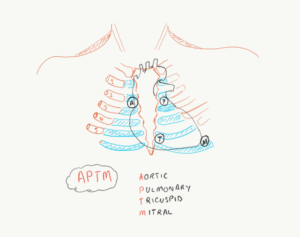Read the question here: https://www.drbeen.com/blog/drbeen-question-4001/
The correct answer is A.
Note the location of the auscultation point for the aorta (A) in this diagram before reading the explanation.

Explanation
Patient has aortic stenosis. Aortic stenosis murmur is the best heard at the 2nd intercostal on the right side. Murmur radiates to carotids. Usually associated with ventricular hypertrophy which causes the apical beat to displace to the mid-axillary line at the 6th intercostal space on the left. There often is a systolic thrill as well.
This murmur is similar to the murmur in HOCM. However, their intensity profiles are opposite to each other. In aortic stenosis, Valsalva’s maneuver reduces the venous return which reduces the ejecting blood. The reduced outflow of blood, in turn, results in the reduced murmur intensity. Similarly, squatting increases the venous blood return, increasing the pre-load. Increased pre-load, in turn, increases the amount of blood ejecting through the aortic valve which results in higher murmur intensity. In HOCM opposite occurs. Reduced pre-load causes the obstruction to increase because of smaller chamber size which increases the murmur intensity. Increased pre-load dilates the chamber offering a wider opening for the ejecting blood, and results in the reduced intensity of the murmur.
B is incorrect. Pulmonary valve stenosis is best heard at the second intercostal space on the left side of the sternum.
C is incorrect as the ventricular septal defect is best heard at the 5th intercostal space on the left side of the sternum. It is also a holosystolic murmur.
D is incorrect because the patent foramen ovale (PFO) does not cause a murmur. Remember, on the other hand; a VSD does cause a murmur.
E is incorrect, see the answer for A for more information.

